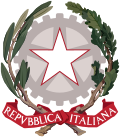This article needs additional citations for verification .(December 2017) |
| Order of the Crown of Italy Ordine della Corona d'Italia | |
|---|---|
 Star of the Grand Cordon set of the Order | |
| Awarded by The Head of the Italian Royal Family | |
| Type | Dynastic Order of Knighthood |
| Established | 20 February 1868 |
| Royal house | House of Savoy |
| Eligibility | Military, civilian |
| Awarded for | Meritorious Service or Achievement |
| Status | Rarely constituted |
| Founder | King Victor Emmanuel II |
| Grand Master | Prince Emanuele Filiberto, Prince of Venice (disputed) Prince Aimone, Duke of Aosta (disputed) |
| Chairman of the Council | Vacant |
| Grades | Knight Grand Cross Grand Officer Commander Officer Knight |
| Precedence | |
| Next (higher) | Royal Order of Saints Maurice and Lazarus |
| Next (lower) | Royal Civil Order of Savoy Royal Military Order of Savoy |
| Ribbon bar | |
The Order of the Crown of Italy (Italian : Ordine della Corona d'Italia or OCI) was founded as a national order in 1868 by King Vittorio Emanuele II, to commemorate the unification of Italy in 1861. [1] It was awarded in five degrees for civilian and military merit. Today the Order of the Crown has been replaced by the Order of Merit of Savoy and is still conferred on new knights by the current disputed head of the house, Emanuele Filiberto, Prince of Venice.
Contents
The order has been suppressed by law since the foundation of the Republic in 1946. However, Umberto II did not abdicate his position as fons honorum and it remained under his Grand Mastership as a dynastic order. While the continued use of those decorations conferred prior to 1951 is permitted in Italy, the crowns on the ribbons issued before 1946 must be substituted for as many five pointed stars on military uniforms. [2]















